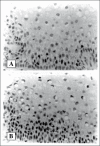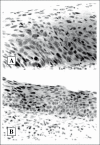An immunohistochemical study of retinoblastoma gene product in normal, premalignant and malignant tissues of the uterine cervix
- PMID: 23365501
- PMCID: PMC3557110
An immunohistochemical study of retinoblastoma gene product in normal, premalignant and malignant tissues of the uterine cervix
Abstract
The retinoblastoma gene was the first tumour suppressor gene identified that was altered not only in retinoblastomas but has been described in a wide variety of human neoplasms. The retinoblastoma gene encodes a nuclear phosphoprotein that in its hypophosphorylated state plays an important role in regulating the cell cycle, thus preventing from tumour formation. Expression of retinoblastoma gene protein product (pRB) was investigated in 118 formalin-fixed, paraffin-embedded cervical tissues by immunohistochemistry using commercially available antibody directed against RB protein. Ten normal ectocervical epithelium, 16 cervical intraepithelial neoplasia (CIN) I, 13 CIN II, 14 CIN III, 53 invasive squamous cell carcinoma, 11 adenocarcinoma and 1 small cell carcinoma were selected for this study. The proportions of pRB-positive cells as well as the extent of pRB expression in ectocervical squamous epithelium were assessed and compared among the lesions. The pRB expression was observed in 100% of normal ectocervical epithelium (n=10), 100% of CIN lesions (n=43) and 98.5% of invasive carcinoma of the uterine cervix (n=65) and were statistically significant when CIN or CIN/invasive were compared to normal cases (P < 0.01, P < 0.05 respectively). While in invasive squamous cell carcinoma (SCC), 81.8% (9/11) pRB-positive cells were found in much higher percentages in well differentiated SCC compared to 64.3% (18/28) of moderately differentiated cases and only 7.1% (1/14) of poorly differentiated SCC (P < 0.01, respectively). The results of this study suggest that loss of RB protein expression is rare in carcinoma of the uterine cervix and this protein may be important in the pathogenesis of cervical carcinoma.
Keywords: Uterine cervix; immunohistochemistry; pRB.
Figures



Similar articles
-
[Cervix dysplasias: study of Rb and p53 gene expression and correlation with mitotic activity].Gynecol Obstet Fertil. 2000 Jan;28(1):44-50. Gynecol Obstet Fertil. 2000. PMID: 10774117 French.
-
Immunohistochemical detection of sex steroid receptors, cyclins, and cyclin-dependent kinases in the normal and neoplastic squamous epithelia of the uterine cervix.Cancer. 1998 May 1;82(9):1709-19. doi: 10.1002/(sici)1097-0142(19980501)82:9<1709::aid-cncr18>3.0.co;2-8. Cancer. 1998. PMID: 9576293
-
Alterations found in pl6/Rb/cyclin D1 pathway in the dysplastic and malignant cervical epithelium.Oncol Res. 2007;16(11):527-33. doi: 10.3727/096504007783438367. Oncol Res. 2007. PMID: 18306932
-
Glutathione S-transferase pi is expressed in (pre) neoplastic lesions of the human uterine cervix irrespective of their degree of severity.Anticancer Res. 1997 Nov-Dec;17(6D):4305-9. Anticancer Res. 1997. PMID: 9494525
-
Development of an optimal protocol for antigen retrieval: a 'test battery' approach exemplified with reference to the staining of retinoblastoma protein (pRB) in formalin-fixed paraffin sections.J Pathol. 1996 Jul;179(3):347-52. doi: 10.1002/(SICI)1096-9896(199607)179:3<347::AID-PATH559>3.0.CO;2-L. J Pathol. 1996. PMID: 8774494
Cited by
-
LIMD1 is more frequently altered than RB1 in head and neck squamous cell carcinoma: clinical and prognostic implications.Mol Cancer. 2010 Mar 12;9:58. doi: 10.1186/1476-4598-9-58. Mol Cancer. 2010. PMID: 20226061 Free PMC article.
References
-
- Scheffner M, Romanezuk H, Munger K, Huibregtse JM, Mietz JA, Howley PM. Functions of human papillomavirus protein in human pathogenic papilloma - viruses. In: zur Hausen H, editor. Current topics in microbiology and immunology. Vol. 186. Berlin: Springer-Verlag; 1994. p. 83. - PubMed
-
- Devesa SS, Young JL, Jr, Brinton LA, Fraumeni JF., Jr Recent trends in cervix uteri cancer. Cancer. 1989;64:2184–2190. - PubMed
-
- Smith HO, Tiffany MF, Qualls CR, Key CR. The rising incidence of adenocarcinoma relative to squamous cell carcinoma of the uterine cervix in the United States - A 24 years population ñ base study. Gynecol Oncol. 2000;78(2):97–105. - PubMed
-
- Bishop JM. Molecular themes in oncogenesis. Cell. 1991;64:235–248. - PubMed
LinkOut - more resources
Full Text Sources
Research Materials
